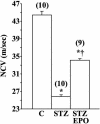Erythropoietin both protects from and reverses experimental diabetic neuropathy
- PMID: 14718663
- PMCID: PMC321765
- DOI: 10.1073/pnas.0307823100
Erythropoietin both protects from and reverses experimental diabetic neuropathy
Abstract
Erythropoietin (EPO) possesses generalized neuroprotective and neurotrophic actions. We tested the efficacy of recombinant human EPO (rhEPO) in preventing and reversing nerve dysfunction in streptozotocin (STZ)-induced diabetes in rats. Two days after STZ [60 mg/kg of body weight (b.w.), i.p.], diabetic animals were administered rhEPO (40 microg/kg of b.w.) three times weekly for 5 weeks either immediately (preventive) before or after a 5-week delay (therapeutic) after induction of hyperglycemia or at a lower dose (8 microg/kg of b.w. once per week) for 8 weeks (prolonged). Tail-nerve conduction velocities (NCV) was assessed at 5 and 11 weeks for the preventive and therapeutic schedule, respectively. Compared to nondiabetic rats, NCV was 20% lower after 5 weeks in the STZ group, and this decrease was attenuated 50% by rhEPO. Furthermore, the reduction of Na(+),K(+)-ATPase activity of diabetic nerves (by 55%) was limited to 24% in the rhEPO-treated group. In the therapeutic schedule, NCV was reduced by 50% after 11 weeks but by only 23% in the rhEPO-treated group. rhEPO treatment attenuated the decrease in compound muscle action potential in diabetic rats. In addition, rhEPO treatment was associated with a preservation of footpad cutaneous innervation, as assessed by protein gene product 9.5 immunostaining. Diabetic rats developed alterations in mechanical and thermal nociception, which were partially reversed by rhEPO given either in a preventative or therapeutic manner. These observations suggest that administration of rhEPO or its analogues may be useful in the treatment of diabetic neuropathy.
Figures






References
-
- Anonymous (1993) N. Engl. J. Med. 329, 977–986. - PubMed
-
- Anonymous (1995) Ann. Intern. Med. 122, 561–568. - PubMed
-
- Vinik, A. I., Milicevic, Z. & Pittenger, G. L. (1995) Diabetes Care 18, 1037–1041. - PubMed
-
- Benbow, S. J., Wallymahmed, M. E. & MacFarlane, I. A. (1998) Q. J. Med. 91, 733–737. - PubMed
Publication types
MeSH terms
Substances
LinkOut - more resources
Full Text Sources
Other Literature Sources
Medical
Research Materials

